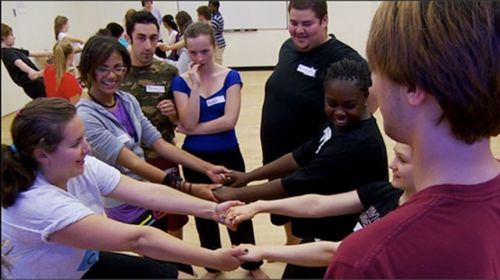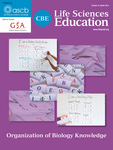Science Choreography: A Movement-Based Approach to Biology Teaching
Dear Editor:
We would like to bring to the attention of readers a novel participatory movement–based technique we have been using to teach science and to encourage students to think creatively about science: science choreography. The project evolved as part of a Howard Hughes Medical Institute–funded multiyear collaboration between a team of scientist-educators at Wesleyan University and other institutions and dancer-choreographers from the Liz Lerman Dance Exchange. When the sequencing of the human genome was announced to the public, choreographer and MacArthur Fellow Liz Lerman was one of many who asked what this might mean for our future and the future of our children. To help answer these questions, she decided to make a multimedia piece, Ferocious Beauty: Genome, in collaboration with scientists at Wesleyan University and across the country (Science Choreography, 2011). After the work premiered, it became evident to us that we could use video performance clips from Ferocious Beauty: Genome as a “second textbook”—a launching point and source of enrichment for learning and thinking about concepts in biology. We also came to realize that a number of the tools used in dance making by the Dance Exchange could be easily adapted for use in the classroom, either alone or in combination with video clips from Ferocious Beauty: Genome.
We were motivated by a variety of challenges faced by science teachers at all levels, including the perception by some that our subjects are difficult to teach and hard to learn, as well as threatening or uninteresting to many. Our immediate goal was to make science more accessible to a broad base of students. One target student is the kinesthetic learner (Gardner, 1983; Snyder 2000). The value of a movement-based approach in reaching a diverse student body is underscored by the observation that embodied learning is particularly effective at engaging at-risk teens and ethnic minorities (Park, 1997; Tanner and Allen, 2004).
Our work together has generated a website for science educators from middle school through college (Science Choreography, 2011). It provides a rationale for the approach; descriptions of a toolbox of teaching and learning exercises, including video demonstrations; and examples of content-based modules we have developed on a number of topics. Imagine students who have recently begun to explore concepts of genetics—phenotypes, genes, genetic crosses—meeting with Gregor Mendel, the father of genetics, to discuss his experiences as a founding scientist in biology. What was he thinking? What led him to design his classic experiments? How is modern biology dependent on Mendel's pioneering work? What is a gene? These are some core questions that students and teachers can raise in the Genes and Mendel module, which includes a clip from Ferocious Beauty: Genome that features a dancer in the character of Mendel. In another module, we focus on bringing ethical considerations into biology teaching, a challenge for which science teachers may feel they do not have the necessary expertise. In the Ethics and Genetic Testing module, we use two tools: Ask a Question in small groups or Walk and Talk in larger settings, to transition from a lecture-style, PowerPoint-based presentation on the “why, what, when, and how?” of genetic testing to thinking and talking personally about related ethical issues, with questions such as “Would you want to get a genetic test for a disease?,” What if you were predisposed to it?,” “Who should know the results?” We also view a relevant segment of Ferocious Beauty: Genome that features a performer with osteogenesis imperfecta who dances in a wheelchair and on crutches. In the DNA Helix module, the aim is for students to learn DNA properties from one another and engage in model building, but rather than using the machined metal pieces Watson and Crick used, they use their own bodies (Figure 1). By doing this in stages, the students can start to understand more viscerally what the structures are, and how some models are more robust than others. The embodying tools are designed so they can be used independently of the specific modules, for example, as a kinesthetic mnemonic to help students remember a pathway or as a means for an instructor to find out what students know about a specific topic. Getting the students up on their feet in the midst of a conventional sedentary classroom setting is restorative and invigorating.
Figure 1. High school students building DNA.
While informal feedback and survey responses from students and teachers has been positive (Science Choreography, 2011), future studies are needed to directly test the efficacy of the approach.
ACKNOWLEDGMENTS
We thank Pamela Tatge, Director of the Center for the Arts at Wesleyan, for her vision and commitment to this project; the Howard Hughes Medical Institute and the Mellon Foundation for funding; and all the faculty, teachers, and students who have participated, including the students and staff of the Center for Creative Youth.
FOOTNOTES
†This letter is dedicated to Laurel Appel, 1962–2013, a core contributor throughout this project.



